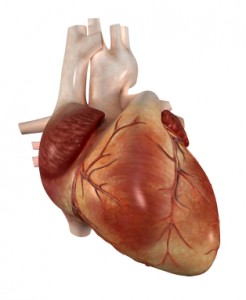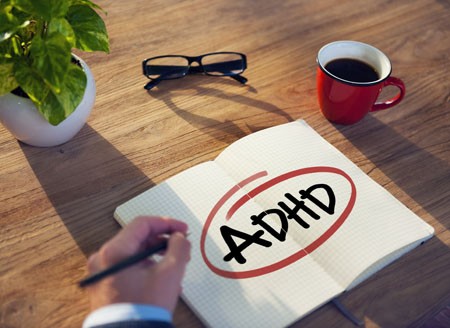Marker of Heart Failure May Predict Brain Deterioration
 A protein released into the blood in response to heart failure may be able to predict brain deterioration before clinical symptoms appear. The protein, N-terminal pro-B-type natriuretic peptide (NT-proBNP), is released when cardiac walls are under stress. High levels of NT-proBNP in the blood are a sign of heart disease. A 2016 Dutch study indicated that high levels of NT-proBNP in the blood are also linked to smaller brain volume, particularly small gray matter volume, and to poorer organization of the brain’s white matter. The study by researcher Hazel I. Zonneveld and colleagues, published in the journal Neuroradiology, assessed heart and brain health in 2,397 middle-aged and elderly people with no diagnosed heart or cognitive problems.
A protein released into the blood in response to heart failure may be able to predict brain deterioration before clinical symptoms appear. The protein, N-terminal pro-B-type natriuretic peptide (NT-proBNP), is released when cardiac walls are under stress. High levels of NT-proBNP in the blood are a sign of heart disease. A 2016 Dutch study indicated that high levels of NT-proBNP in the blood are also linked to smaller brain volume, particularly small gray matter volume, and to poorer organization of the brain’s white matter. The study by researcher Hazel I. Zonneveld and colleagues, published in the journal Neuroradiology, assessed heart and brain health in 2,397 middle-aged and elderly people with no diagnosed heart or cognitive problems.
Researchers are working to clarify the relationship between cardiac dysfunction and preliminary brain disease, but researcher Meike Vernooij says it is likely cardiac dysfunction comes first and leads to brain damage. Measuring biomarkers such as NT-proBNP may help identify brain diseases such as stroke and dementia earlier and allow for earlier treatment and lifestyle changes that can slow or reverse the course of disease.
In Case Control Study, Two-Thirds of Patients With Severe Depression Had Underlying Metabolic Abnormalities
 A recent study suggests that potentially treatable metabolic abnormalities in the central nervous system may underlie a large proportion of cases of severe, treatment-resistant depression. These abnormalities, such as folate deficiency in the cerebrospinal fluid, are not screened for regularly, as they require a spinal tap to diagnose.
A recent study suggests that potentially treatable metabolic abnormalities in the central nervous system may underlie a large proportion of cases of severe, treatment-resistant depression. These abnormalities, such as folate deficiency in the cerebrospinal fluid, are not screened for regularly, as they require a spinal tap to diagnose.
Researchers led by Lisa A. Pan were inspired to assess metabolic function in people with treatment-resistant depression after a young patient with severe, persistent depression who had attempted suicide several times improved dramatically after being diagnosed with a tetrahydrobiopterin deficiency in his cerebrospinal fluid and treated for the deficiency. Tetrahydrobiopterin is critical to the production of monoamine neurotransmitters.
The researchers carried out a case-control study of 33 teen and young adult patients who had had treatment-resistant depression since childhood and 16 healthy control participants. Twenty-one of the 33 patients with severe depression had metabolic abnormalities in their cerebrospinal fluid. Twelve had cerebral folate deficiencies (but no folate deficiency in blood tests). Those who took folinic acid for at least six weeks (1–2 mg/kg/day) in addition to their regular medications showed sometimes dramatic improvement in their depression.
Other metabolic issues identified in the patients with severe depression included abnormal levels of acylcarnitine in five patients, low tetrahydrobiopterin intermediates in one, low guanidinoacetate in another, and unusual creatine/creatinine ratios in three patients. None of the healthy participants had any metabolic abnormality.
While the study, published in the American Journal of Psychiatry in 2017, was small, it suggests that the underlying causes of some severe depression cases are going undiagnosed and untreated. The authors suggest that assessment of metabolic function should be more common in cases of severe treatment-resistant depression.
Measuring Inflammation in Neuropsychiatric Disorders May Shed Light on Treatment
Meta-analyses have found links between elevated levels of inflammatory markers and many neuropsychiatric disorders, including depression, bipolar disorder, schizophrenia, post-traumatic stress disorder (PTSD) and traumatic brain injury. Multiple studies also show that those with elevated inflammatory markers such as interleukin-1, interleukin-6, tumor necrosis factor (TNF) alpha, and c-reactive protein (CRP) also respond less well to typical treatments than those with normal levels of these markers in the blood.
These links suggest that it could be useful to measure levels of these inflammatory markers in the blood of people who are responding poorly to medications. If one or more of these markers are elevated, it might be a sign that treatment with an anti-inflammatory agent could be helpful. Preliminary studies have shown that some neuropsychiatric disorders may improve after treatment with anti-inflammatory drugs such as aspirin, celecoxib (Celebrex), and the antibiotic minocycline, among others.
Anxiety, Depression, Unstable Mood, and Low-Level Mania Best Predictors of Bipolar Disorder
Researchers are looking for better ways of predicting whether children at risk for bipolar disorder will go on to develop the illness. A 2015 study by David Axelson and colleagues in the American Journal of Psychiatry reported that in the offspring of parents with bipolar disorder, diagnoses of sub-threshold mania, depression, and disruptive behavior disorders were associated with subsequent diagnosis of full-blown Bipolar I or Bipolar II disorders six to seven years later.
More recently, in an article by Danella M. Hafeman and colleagues in the American Journal of Psychiatry, the same group of investigators has examined how symptoms (rather than categorical diagnoses, as in the earlier study) predict the development of bipolar disorder. In children and adolescents at high risk for bipolar disorder (because they have a parent with the disorder) three types of symptoms were the best predictors of later bipolar disorder: anxiety/depression at the time participants entered the study, unstable mood or irritability both when entering the study and shortly before a bipolar diagnosis, and low-level manic symptoms observed shortly before diagnosis.
The earlier the age at which a parent was diagnosed with a mood disorder, the greater the risk that the offspring would also be diagnosed with bipolar disorder. Youth with all four risk factors (anxiety or depression, mood changes, low-level mania, and a parent who was diagnosed with a mood disorder at an early age) had a 49 percent chance of developing bipolar disorder, compared to a 2 percent chance among those without those risk factors.
Childhood onset of bipolar disorder and long delays until first treatment for depression or mania are both significant predictors of a poor outcome in adulthood compared to adult onsets and shorter delays to treatment. Read more
Changes in Sense of Humor May Be Warning Sign of Dementia
 A change in a person’s sense of humor could be an early indicator of dementia, according to a 2015 article by Jason Warren and colleagues in the Journal of Alzheimer’s Disease. The changes can appear as early as 10 years before a diagnosis of dementia. Almost all participants who would go on to be diagnosed with frontotemporal dementia showed an increased preference for slapstick humor over satirical or absurdist compared with those who would not. In contrast, changes in sense of humor appeared in less than half of those who would go on to be diagnosed with Alzheimer’s disease, indicating that changes in sense of humor may allow doctors to distinguish between different types of dementia.
A change in a person’s sense of humor could be an early indicator of dementia, according to a 2015 article by Jason Warren and colleagues in the Journal of Alzheimer’s Disease. The changes can appear as early as 10 years before a diagnosis of dementia. Almost all participants who would go on to be diagnosed with frontotemporal dementia showed an increased preference for slapstick humor over satirical or absurdist compared with those who would not. In contrast, changes in sense of humor appeared in less than half of those who would go on to be diagnosed with Alzheimer’s disease, indicating that changes in sense of humor may allow doctors to distinguish between different types of dementia.
The study has some limitations. It was small (48 patients) and relied on patients’ memory of what kind of humor they enjoyed 15 years earlier. More research is needed to clarify the link between changes in humor preferences and dementia.
Warren suggests that changes in humor appear before other warning signs of dementia, such as memory loss. He called humor a type of “stress test” for the brain, since getting a joke can require a quick shift in perspective.
Diagnosing PANS
Pediatric Acute-Onset Neuropsychiatric Syndrome, or PANS, describes a condition in which a child develops acute onset of psychiatric symptoms following an infection. At the 2015 meeting of the American Academy of Child and Adolescent Psychiatry, researcher Tanya K. Murphy reported on symptoms that differentiate PANS from other childhood-onset illnesses. Kids with PANS are more likely to have:
- sudden onset of symptoms
- earlier age of onset
- personality changes
- new onset of attention deficit hyperactivity disorder (ADHD) symptoms
- food refusal and weight loss
- behavioral regression
- deterioration in handwriting
- severe sleep disruption
- psychosis
- memory problems
- frequent urination
- dilated pupils
- an infection at the time of onset, particularly a group A streptococcal infection
A child with sudden onset of these symptoms following an infection may have PANS. It is important to differentiate PANS from traditional psychiatric diagnoses because treatment of PANS often consists of antibiotics, anti-inflammatory medications, and other treatments that target the immune system. See our case report about a boy with PANS.
Schizophrenia: The Importance of Catching It Early
By the time psychosis appears in someone with schizophrenia, biological changes associated with the illness may have already been present for years. A 2015 article by R.S. Kahn and I.E. Sommer in the journal Molecular Psychiatry describes some of these abnormalities and how treatments might better target them.
One such change is in brain volume. At the time of diagnosis, schizophrenia patients have a lower intracranial volume on average than healthy people. Brain growth stops around age 13, suggesting that reduced brain growth in people with schizophrenia occurs before that age.
At diagnosis, patients with schizophrenia show decrements in both white and grey matter in the brain. Grey matter volume tends to decrease further in these patients over time, while white matter volume remains stable or can even increase.
Overproduction of dopamine in the striatum is another abnormality seen in the brains of schizophrenia patients at the time of diagnosis.
Possibly years before the dopamine abnormalities are observed, underfunctioning of the NMDA receptor and low-grade brain inflammation occur. These may be linked to cognitive impairment and negative symptoms of schizophrenia such as social withdrawal or apathy, suggesting that there is an at-risk period before psychosis appears when these symptoms can be identified and addressed. Psychosocial treatments such as individual, group, or family psychotherapy and omega-3 fatty acid supplementation have both been shown to decrease the rate of conversion from early symptoms to full-blown psychosis.
Using antipsychotic drugs to treat the dopamine abnormalities is generally successful in patients in their first episode of schizophrenia. Use of atypical antipsychotics is associated with less brain volume loss than use of the older typical antipsychotics. Treatments to correct the NMDA receptor abnormalities and brain inflammation, however, are only modestly effective. (Though there are data to support the effectiveness of the antioxidant n-acetylcysteine (NAC) on negative symptoms compared to placebo.) Kahn and Sommer suggest that applying treatments when cognitive and social function begin to be impaired (rather than waiting until psychosis appears) could make them more effective.
The authors also suggest that more postmortem brain analyses, neuroimaging studies, animal studies, and studies of treatments’ effects on brain abnormalities are all needed to clarify the causes of the early brain changes that occur in schizophrenia and identify ways of treating and preventing them.
Diagnosing Childhood Bipolar Disorder: Mom Knows Best
In a talk at the 2015 meeting of the International Society for Bipolar Disorders, researcher Eric Youngstrom showed that mothers’ evaluation of their children’s psychiatric symptoms was more valid than both teacher ratings and the children’s own evaluations. Parents were better at detecting irritability, while children were better at assessing their energy levels and the quality of their sleep.
Youngstrom reported that about 2% of children worldwide are diagnosed with bipolar disorder. However, when bipolar disorder not otherwise specified (BP NOS), a diagnosis given when symptoms do not meet the diagnostic criteria for Bipolar I or II, is included in the statistics, rates of bipolar disorder among children in the US reach about 6%.
Youngstrom mentioned that an epidemiological study by Kathleen Merikangas found that among children in the US with a bipolar spectrum diagnosis, only 22% were in treatment, compared to 38% of those with depression and 60% of those with ADHD.
Parents of children (aged 2–12) with mood, anxiety, and behavioral disorders are invited to join the Child Network, our program for tracking weekly symptoms which can then be printed out longitudinally to share with the child’s doctor.
A PANS Case Study, Immune Treatment Reduced Psychiatric Symptoms
Pediatric acute neuropsychiatric syndrome (PANS) is a little-known syndrome in which a child has an acute onset of psychiatric symptoms following a bacterial or viral infection, when the antibodies generated to fight the infection instead attack neurons in the brain. The behavioral alterations can be severe and resistant to the usual psychotropic drug treatments. PANS often requires antibiotics and immune-targeted therapies.
The following is a case report of a real child who had a sudden onset of depression and violence after getting sick with the flu, pneumonia, and a strep infection at the age of 4. (Names have been changed for privacy.)
Anne contacted this editor (Robert M. Post) seeking a consultation on her 6-year-old son, Jake. Two years earlier, he had suddenly become difficult—depressed, angry, and even violent. This coincided with the emergence of obsessive compulsive symptoms and urinary incontinence. He went from being able to read short sentences in pre-kindergarten, to being cognitively dull and not even able to recognize letters of the alphabet. He had been diagnosed with a mood disorder, and Anne was told it was probably bipolar disorder. But he didn’t respond to any of the typical medications, and suffered side effects including hallucinations, nightmares, bowel accidents, and worsening depression.
The best results came with the atypical antipsychotic risperidone. While it didn’t reduce all of Jake’s symptoms, Anne described it as “heaven” compared to earlier treatments. But Jake’s levels of prolactin started to increase, and he lost bladder control, so he had to stop taking risperidone. Jake’s doctor tried 18 different medication regimens with 8 different medications in less than a year without finding one that worked well. Jake had a horrible time in school, and Anne fretted about the lack of an effective, stable medication, saying, “He’s actually worse than I’ve ever seen him.”
Dr. Post recommended that they consider using high doses of quetiapine and valproate for Jake’s aggression and behavioral dyscontrol, along with the antioxidant N-acetylcysteine and vitamin D3. However, given that Jake’s symptoms were severe, involved cognitive and neurological abnormalities, and had begun after a flu-like illness, and was unresponsive to conventional treatment, Dr. Post suggested that Anne get Jake checked out for PANS and start charting Jake’s mood on a daily basis.
Jake began taking higher doses of quetiapine and valproate, and improved to the point that Anne said they restrained him only once a day, rather than four times per day. But his behavioral dyscontrol continued. In one memorable incident, after feeling picked on by other children at a baseball game, he lashed out at Anne, kicking her in the face with his cleats and punching her glasses off her face.
Anne told Dr. Post that the family had visited a neurologist, who said that she had never heard of PANS and suggested that Anne would have to travel across several states to see Dr. Post if she wanted to pursue that diagnosis.
Dr. Post encouraged Anne to keep looking for a doctor who would take the PANS idea seriously. He sent her a comprehensive review article about PANS by Dr. Kiki Chang and colleagues published in the Journal of Child and Adolescent Psychopharmacology in 2014.
This past June, Anne found a doctor who understood PANS and was willing to run the appropriate tests on Jake. The tests revealed that Jake had at one time been infected with the bacteria mycoplasma. Read more
Surprisingly, Adult ADHD Is Distinct From Childhood ADHD
In a longitudinal study of 1,037 people born in Dunedin, New Zealand in 1972 and 1973, most participants with attention deficit hyperactivity disorder (ADHD) in adulthood did not have the disorder as children. The study by Terrie E. Moffitt and colleagues in the American Journal of Psychiatry is the first prospective longitudinal study to describe the childhood of adults with ADHD.
When the study participants were children, about 6% were diagnosed with ADHD (mostly males). These children also had comorbid disorders, neurocognitive deficits, multiple genes associated with risk for ADHD, and some life impairment when they reached adulthood.
In adulthood, about 3% of the participants had ADHD (roughly equal between men and women), and 90% of these participants had no history of ADHD in childhood. The participants with ADHD in adulthood also had substance dependence and life impairment, and had sought treatment for the disorder. The researchers were surprised to find that these participants with adult ADHD did not show neuropsychological deficits in childhood, nor did they have the genetic risk factors associated with childhood ADHD.
If the findings of this study are replicated, researchers will have to rethink the current classification of ADHD as a neurodevelopment disorder that begins in childhood, and begin to determine how adult ADHD develops.
Editor’s Note: Before the publication of this article, most investigators (including this editor Robert M. Post) thought that virtually all ADHD in adulthood evolved from the childhood disorder, and if it did not begin in childhood, the diagnosis was suspect. I still believe the ADHD that appears in adulthood in patients with bipolar disorder is likely attributable to residual depression and anxiety or hypomania and that more concerted treatment of the patient to full remission will often result in much better attention, concentration, and ability to follow through and stay on task.








